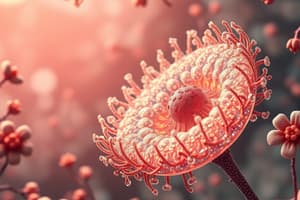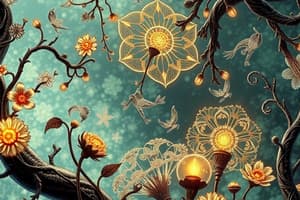Podcast
Questions and Answers
Which of the following solutions is hypertonic to a cell?
Which of the following solutions is hypertonic to a cell?
- A solution with a higher concentration of solute than the cell interior (correct)
- A solution with only water
- A solution with a lower concentration of solute than the cell interior
- A solution with the same concentration of solute as the cell interior
Enzymes can function at any temperature without affecting their activity.
Enzymes can function at any temperature without affecting their activity.
False (B)
What is the primary function of ribosomes in a cell?
What is the primary function of ribosomes in a cell?
Protein synthesis
The chemical equation for photosynthesis is 6CO2 + 6H2O → C6H12O6 + 6O2, where glucose is produced from carbon dioxide and ______.
The chemical equation for photosynthesis is 6CO2 + 6H2O → C6H12O6 + 6O2, where glucose is produced from carbon dioxide and ______.
Match the following types of tissue with their primary function:
Match the following types of tissue with their primary function:
Which of the following correctly describes the function of connective tissue?
Which of the following correctly describes the function of connective tissue?
The left ventricle pumps deoxygenated blood to the body.
The left ventricle pumps deoxygenated blood to the body.
What is the primary function of the kidneys?
What is the primary function of the kidneys?
The _____ is the part of the female reproductive system that connects the uterus to the outside of the body.
The _____ is the part of the female reproductive system that connects the uterus to the outside of the body.
Match the brain lobes with their primary functions:
Match the brain lobes with their primary functions:
Flashcards
Epithelial Tissue
Epithelial Tissue
A type of tissue that covers the surface of the body and lines internal organs, forming a protective barrier and facilitating absorption and secretion.
Nervous Tissue
Nervous Tissue
Carries signals throughout the body, enabling communication between different parts of the nervous system and the rest of the body.
Muscle Tissue
Muscle Tissue
Responsible for movement, including voluntary and involuntary contractions.
Connective Tissue
Connective Tissue
Signup and view all the flashcards
Scientific Method: Steps
Scientific Method: Steps
Signup and view all the flashcards
How does a microscope work?
How does a microscope work?
Signup and view all the flashcards
Diffusion and Osmosis
Diffusion and Osmosis
Signup and view all the flashcards
Prokaryotic vs. Eukaryotic Cells
Prokaryotic vs. Eukaryotic Cells
Signup and view all the flashcards
Enzymes: Function & Characteristics
Enzymes: Function & Characteristics
Signup and view all the flashcards
Study Notes
Scientific Method and Microscopy
- The scientific method involves a series of steps: observation, question, hypothesis, prediction, experiment, analysis, and conclusion.
- Microscopy uses lenses to magnify samples. Focusing involves adjusting the coarse and fine focus knobs to achieve clarity.
Cell Structure and Function
- Diffusion is the movement of molecules from high to low concentration.
- Osmosis is the diffusion of water across a selectively permeable membrane.
- Prokaryotic cells lack a nucleus and membrane-bound organelles; eukaryotic cells possess both.
- Plant cells contain chloroplasts and a cell wall; animal cells do not. Organelles have specific functions.
- Isotonic solutions have equal solute concentrations inside and outside the cell.
- Hypertonic solutions have a higher solute concentration outside the cell, water moves out.
- Hypotonic solutions have a lower solute concentration outside the cell, water moves in.
- The pH scale measures acidity and alkalinity.
Chemical Composition of Cells
- Biuret reagent tests for proteins (purple/violet = positive); iodine tests for starch (dark purple/blue-black = positive); Benedict's reagent tests for sugars (green/yellow/orange/brick red = positive).
Enzymes
- Enzymes are biological catalysts that speed up reactions.
- Enzymes catalyze both synthesis (building) and degradation (breaking down) reactions.
- The active site is where the substrate binds to the enzyme.
- Enzyme-substrate complexes form during reactions.
- Enzyme activity is affected by concentration, temperature, and pH.
Cellular Respiration
- Cellular respiration is the process of breaking down glucose to release energy. It produces ATP (energy).
- Sugar fermentation rate correlates with CO2 production over time.
Photosynthesis
- Photosynthesis uses light energy to convert carbon dioxide and water into glucose and oxygen.
- Photosynthesis takes place in chloroplasts within the plant cell.
- Photosynthesis produces glucose and oxygen.
- The Calvin cycle is a part of photosynthesis, converting carbon dioxide to sugars.
Animal Organization
- Epithelial tissue covers body surfaces; nervous tissue transmits signals; muscle tissue contracts; connective tissue supports and connects.
- Muscle tissue types include skeletal, cardiac, and smooth.
Cardiovascular System
- The heart's components include chambers (atria and ventricles) and valves.
- Blood flows through the heart in a specific pattern, oxygenated and deoxygenated.
- Directional terms (anterior, posterior, ventral, dorsal) describe body positions.
Urinary System
- The urinary system (kidneys, ureters, urethra, bladder) filters blood and produces urine.
- Kidneys filter waste from the blood.
Reproductive System
- The male reproductive system includes the testes, epididymis, vas deferens, seminal vesicles, prostate gland, urethra, and penis. The parts play distinct roles in reproduction.
- The female reproductive system includes the ovaries, fallopian tubes, uterus, and vagina. The parts play distinct roles in reproduction.
Nervous System
- The nervous system has central (brain and spinal cord) and peripheral (nerves) divisions.
- The brain has lobes (frontal, parietal, temporal, occipital) with specific functions.
- The cerebellum coordinates movement; the thalamus relays sensory information; the corpus callosum connects the brain hemispheres.
Special Senses (Eyes and Ears)
- Rod cells in the eye detect light; cone cells detect color.
- Visual information travels from the eye to the brain for processing.
- Hair cells in the ear vibrate, transferring sound vibrations.
- Auditory information is processed in the temporal lobe of the brain.
Studying That Suits You
Use AI to generate personalized quizzes and flashcards to suit your learning preferences.




